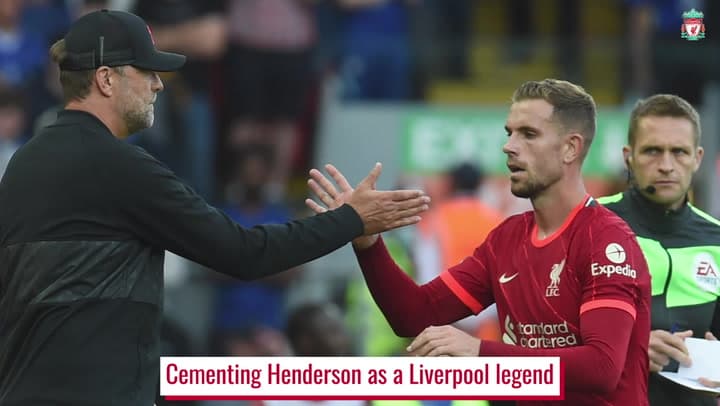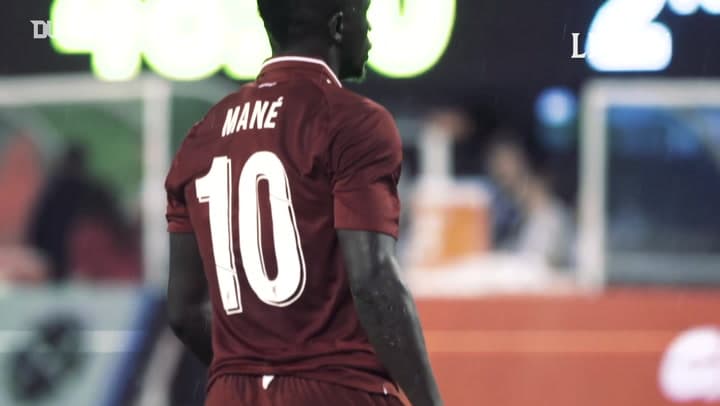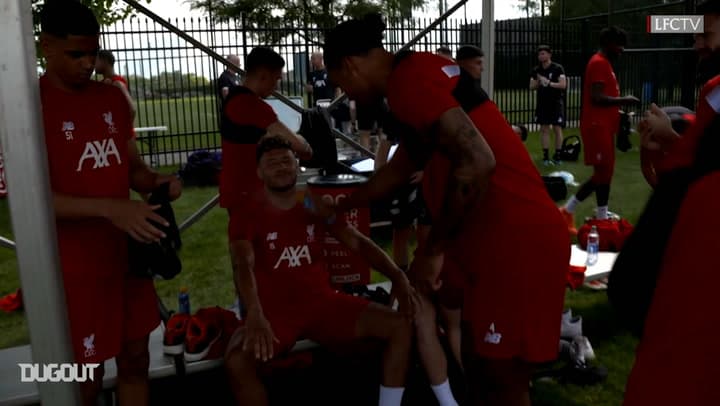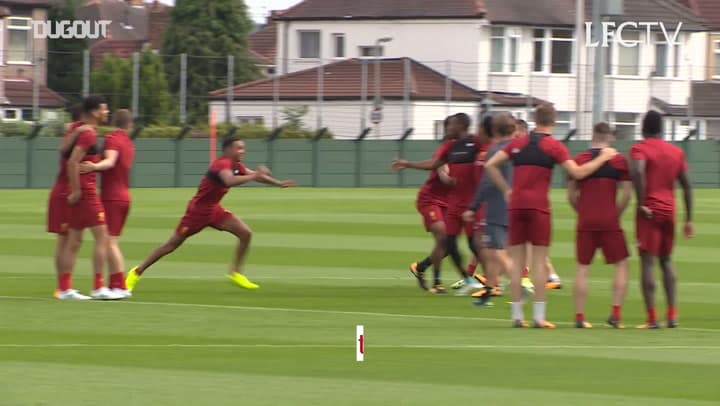OneFootball
Lewis Ambrose·26 June 2020
🏆 From chaos to control: How Klopp built a title-winning machine

In partnership with
Yahoo sportsOneFootball
Lewis Ambrose·26 June 2020

Remember when Jürgen Klopp arrived at Liverpool? They were all over the place.
It wasn’t even five years ago but he had a host of error-prone defenders, some mercurial midfielders – mixed in with some ageing players – and an attack leaning on an injury-prone Daniel Sturridge, a slapstick Divock Origi and a misfiring Roberto Firmino.

His reaction, understandably, was to lean into chaos. Just as he had done at Borussia Dortmund.
Press like hungry dogs. Fight for every ball. Don’t allow the opposition to play.
While at the Westfalenstadion, the approach helped him turn Dortmund from fallen giants to league (2011, 2012) and cup (2012) winners, then Champions League finalists (2013).

Too often, Klopp’s first Liverpool side couldn’t really create chances.
Look at his first game, against Tottenham. Led by Mauricio Pochettino, Spurs met fire with fire. The result was a chaotic game that nobody could get a foothold in.
Loose balls were battled for, players were rushed into decisions and the priority for both sides became avoiding a costly mistake. And that was fine.
After all, these same players were led by Brendan Rodgers and too many costly mistakes saw him sacked. However, it was only the first step towards a Liverpool side built in Klopp’s image.
In late 2015, Klopp sent the players to the Kop, to thank the fans for their support after a 2-2 draw with West Brom.

In football, people always say it – that supporters are important – but then you don’t treat them like that. We know without them we wouldn’t play at our highest level, no chance.
It was ridiculed by those outside the club as a ‘celebration’.
Fast-forward a few years and the connection between the players and the fans is better than it’s been for generations.
It gives Liverpool something extra at Anfield, it helps make it a truly terrifying place to visit. And it fits perfectly with Klopp, his vision, his style, and his wish for everyone at the club to pull in the same direction.
By the spring, they were doing exactly that. Liverpool were a superb pressing machine. They created chaos, they inspired panic. The fans believed. And it took the Reds to the Europa League final.

But in Basel, in the Europa League final, the issues were there for all to see.
If Liverpool made the game chaotic, it meant they couldn’t control it either.
Klopp’s first line-ups were focused on pressing to protect a sloppy defence but by the end of the season the team was a little top heavy as he moved from 4-3-3 to 4-2-3-1 in an effort to squeeze more creativity into the team.
The chaos is fine but without control, it doesn’t get you very far.
Liverpool were brilliant until the break but ran out of gas. When Sevilla went ahead, the Reds had no response and not enough quality to turn the game back around.

The start of the 2016/17 season meant a few key changes at Anfield.
All-action, never-say-die midfielder Jordan Henderson was now considered a crucial part of the team.
There was no more messing with 4-2-3-1, as Klopp went back to 4-3-3, looked to increase the ability at the very top end of the pitch and tried to pack the midfield with tireless runners.
That meant Firmino as a No9 and Philippe Coutinho and Sadio Mané either side of him.

The midfield was bursting with energy, with desire, with the “monster mentality” Klopp demands of his players. But it was still a touch too adventurous and the back four and goalkeeper were still too rash.
Liverpool’s deficiencies meant they always had to make a choice.
Go forward with expose their defensive weaknesses or play a little more conservatively and struggle to create chances?
Games were still chaotic but they were only capable of dictating the game at one end of the pitch at a time.
Klopp being Klopp, they leant towards the top end of the pitch and didn’t keep a clean sheet until October.
A brilliant run at the end of the season earned them a Champions League spot but the summer of 2017 was set up to be a turning point.

Liverpool had two big targets heading into the 2017/18 campaign. Mohamed Salah arrived, Virgil van Dijk didn’t.
The attack was complete, the defence remained an achilles’ heel.
Suddenly, creating chances wasn’t a problem anymore. No matter how Klopp lined up his midfield. The German packed the centre of the park with runners, less creative than before, and left the goalscoring to Salah, Mané, and Firmino.
At the turn of the year, Liverpool already had 50 Premier League goals. They’d scored a further 32 in eight Champions League games. Salah had 23 to his name.

But the backline continued to let the side down. Liverpool had conceded 25 goals in the league, more than double Manchester City’s tally, and been battered by City (5-0) and Spurs (4-1) in their only defeats of the season to date.
Dejan Lovren was still error-prone, Joël Matip hadn’t settled well and Joe Gomez was being forced to play right-back.
As long as those issues existed, a title challenge was a distant dream.

January 2018 came around, and Liverpool made two huge decisions.
They bought Virgil van Dijk for a mere £75m (€84.5m) and the Dutchman transformed the heart of the defence almost overnight.
Van Dijk’s awareness, his composure, his physical prowess meant Liverpool could bomb forward and he would make sure the defence wasn’t exposed. A man mountain, in terms of ability, presence, and size. Maybe the club’s greatest ever signing, as well as their most expensive.

The other big change saw Trent Alexander-Arnold become a regular at right-back.
In the remaining 17 games of the Premier League campaign, Klopp’s side conceded just 14 times. And they made their way to the Champions League final.
Led by their miraculous front three, their workaholic midfield, their newly-fixed defence, Liverpool were off to Kiev.
Unfortunately for the Reds, they still had a goalkeeper problem.

Loris Karius made two costly errors and Liverpool’s hunt for a sixth European Cup ended in heartbreak.

On their way to Ukraine, Liverpool came up against Roma and Alisson. The impressive Brazilian had, over the course of the season, emerged as perhaps the finest goalkeeper in Europe.
A couple of months and £67m (€75m) later, Liverpool made him the world’s most expensive goalkeeper (until Chelsea signed Kepa Arrizabalaga later that month).
The team was complete.
With a keeper that doesn’t drop points, but actually wins them, Liverpool have been unstoppable. The midfield works together more effortlessly than ever, while simultaneously putting in more effort than any other midfield around.
That work has allowed Alexander-Arnold and Andrew Robertson to roam free on the wings, providing 42 Premier League assists since the start of the 2018/19 season.

With that duo dominating the flanks, Mané and Salah are more free than ever to work inside and get into dangerous positions.
A much calmer team than before, Liverpool can create that chaos Klopp wanted way back in 2015, unsettling an opponent. But they can also dominate possession, take their time, and pick holes at will.

In their 2017/18 Champions League campaign, Liverpool conceded 16 times in 13 games, including three in the final.
In 2018/19, the Reds went to the final again. They conceded 12 times but they also kept six clean sheets, including one in each round of knockout stages.
In Madrid, in that 2-0 win over Tottenham, they became the first team since 2010 to keep a clean sheet in the final.
Signed in the summer of 2018, Fabinho took a long time to get going. He’s now crucial in midfield, providing more balance and poise than ever as opposition sides sit tight and demand Liverpool break them down.
Inside the organised chaos that we want, that we like, he is like a lighthouse, he controls it. His timing, his vision, his calmness, it gives another dimension to our midfield.
Since the start of 2018/19, Liverpool have won 57 and lost just two of their 67 Premier League games. Last season it wasn’t quite enough, as they missed out to a formidable City side by one point.
In 2019/20, it has been enough. Liverpool have dominated the league like no team ever has.
They are now, finally, for the first time since 1990, the champions of England.

Klopp’s Liverpool embody the belief and ethic and spirit of the best manager in world football right now. They have sold intelligently, they have bought intelligently, they have added strings to their bow.
From chaos with no control, to being able to create chaos and seize control in any given moment of any given game, as if it’s merely a decision they have to make.
In under five years, from a place of despair, Klopp has made this Liverpool side his masterpiece.




















